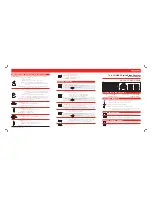
System operation
14
Connections on the rear of the device
Note
Pay attention to the overview on page 3.
No.
Name
Function
8
VIDEO SPOT OUT:
BNC video output
•
When using a HDMI/VGA monitor:
No video signal is displayed.
•
When using no HDMI/VGA monitor:
The video spot signal is displayed..
AUDIO SPOT OUT:
Cinch audio output
9
MAIN:
BNC video output
•
When using a HDMI/VGA monitor:
Video spot signal is displayed.
•
When using no VGA monitor:
The main video signal is displayed.
AUDIO OUT:
Cinch audio output (synchronised
with video output)
10
LINE IN 1, 2:
Cinch audio input
11
VGA:
•
VGA monitor connection (9-pin), video output
signal
12
RS-232:
•
Serial port – no functionality
13
HDMI
•
HDMI monitor connection
14
LAN:
•
Ethernet LAN connection
15
USB port
16
ALARM IN:
•
RS-485 connection for PTZ cameras
•
Max. 16 alarm inputs
ALARM OUT:
•
Max. 4 relay outputs
17
Connection for earthing line
18
Power switch and mains power connection:
•
100–240 V AC, 50–60 Hz
19
LOOP OUT:
Connection for looped video signals
(cable available separately)
20
VIDEO IN:
BNC inputs
AUDIO IN:
Cinch inputs
Note
All audio inputs have no audio amplifier -> the au-
dio signal has to be amplified before connected.
Therefore you can use a microphone amplifier.
Operating elements on the remote control
Note
Pay attention to the remote control diagram on
page 4.
No.
Name
Function
21
DEV:
Assigns the remote control with the device ID
22
Alphanumeric keys:
•
Selects the camera (channel) in the live view
•
Entry of letters and digits in system fields
23
A:
Changes the entry format (upper / lower case,
symbols, digits)
24
PLAY:
Starts playback
25
VOIP
•
Not used
26
PREV:
Changes the screen display in the live view
27
Navigation keys:
During playback:
•
,
Sets the speed
•
⊳
,
Previous / next day
In the live view:
•
Selects the camera (channel selection)
In menus:
•
Navigation
28
ESC:
•
Not used















































